From Rostov to Crimea: How the Russians are Building a Logistics Corridor Through Occupied Ukrainian Pryazovia
What we know about the situation in the ports of occupied Mariupol and Berdiansk and the railways the occupiers are restoring or building near the Sea of Azov.
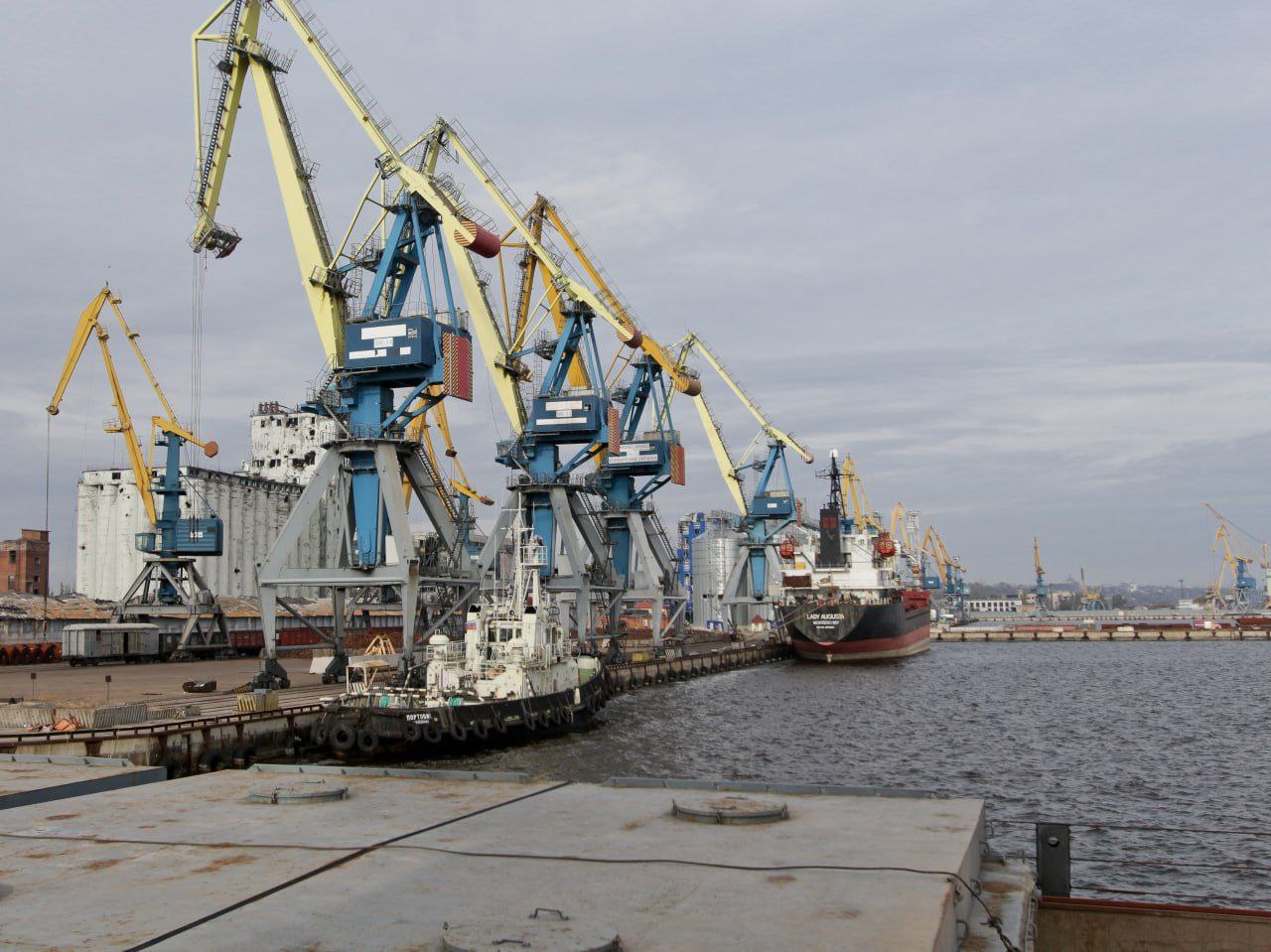
Mariupol, late May 2022. A vessel of the type RM-3 carrying 3,000 tons of seized Ukrainian metal products left the Russian-occupied port and sailed to Rostov-on-Don. This was the beginning of the Russian looting through the port of Mariupol, which soon spread throughout occupied southern Ukraine.
What is happening now in the ports of occupied Mariupol and Berdiansk, and why are the Russians restoring existing railroads and building new ones around the Sea of Azov?
The Ports: They are stealing everything
According to the Russian occupiers and their collaborators, the port of Mariupol handled over 150,000 tons of cargo in 2023, with over 65 vessels processed. However, the accuracy of these figures is questionable, as ships entering the waters of the occupied ports disable their AIS systems, making accurate tracking difficult.
The occupiers report that they managed to export more than 50,000 tons of Ukrainian grain from Mariupol in the first four months of 2024. They are currently loading the grain using the “warehouse-to-ship” method. At least four sea/river vessels are known to be heavily involved in the looting: the Mezhdurechensk, RM3, STK 1003, and STK 1016 ships, each with a maximum capacity of up to 5,000 tons. This pirate fleet is operated by the Russian state-owned construction company Roskapstroy, which openly admits that its four vessels regularly dock in the port of Mariupol. However, it does not publicize the fact that the ships also deliver concrete fortifications for the Russian army’s defensive structures, in addition to building materials for so-called civilian reconstruction. The most recent ship with such cargo arrived in the port of Mariupol in early May 2024.
The main export from the ports of Mariupol and Berdiansk is grain, which accounts for no less than 50% of the total cargo. Other significant exports include metallurgical products, chemical products, and white clay (kaolin) from the Polohy deposit. These goods are being transported by the Russians and their collaborators from the occupied territories of the Donetsk, Luhansk, Zaporizhia, and Kherson regions, with metallurgical products and kaolin being specifically transported to Russia.
A source in the Main Intelligence Directorate of the Ukrainian Ministry of Defense confirmed this information to the CFTS portal: “As of late May 2024, the occupiers are using the appropriated infrastructure of the Ukrainian seaports in the cities of Berdiansk and Mariupol. They are using these ports to illegally export grain harvested in the temporarily occupied territories of Ukraine. To facilitate this, the occupiers have restored grain silos and carried out dredging works in these ports. In addition, products (sheet metal) manufactured by the Azovstal iron and steel works have been observed being exported through the port of Mariupol,” the source in the Main Intelligence Directorate said.
Ships loaded with grain cargoes head to Russian ports, where the cargoes are transferred onto other ships under “flags of convenience” and then transported from Russia to markets in Africa and the Middle East.
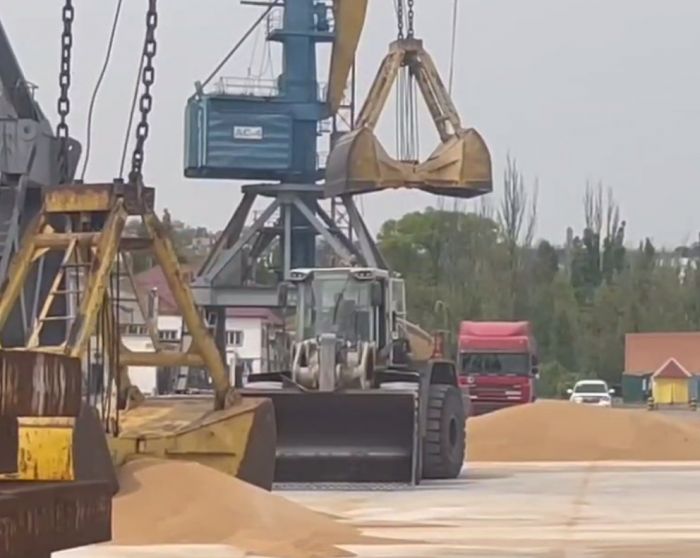
In comments to the CFTS portal, Ihor Barskyi, director of the Mariupol Commercial Seaport, said: “The occupiers are making every effort to restore the damaged port infrastructure and use it for their own purposes. The port, like the city as a whole, has suffered considerably from shelling and bombing. The occupiers have managed to clear the aftermath of the destruction from the area, rebuild the main access roads and railway lines, and restore the electricity supply. The water supply situation is more difficult. Some of the loading facilities have also been partially restored, but not all. The condition of the berths is satisfactory.”
According to him, about 500 people are currently working in the occupied port. The so-called director of the port is a Russian appointed by the occupiers. Several other key positions are also held by Russians. The rest are former port workers and residents of Mariupol.
“Before the full-scale invasion, 2,830 people worked at the port of Mariupol. About 700 people have not been in touch for two years. We assume that most of them are either missing or dead. As for our current activities, we re-registered the company on the Ukrainian-controlled territory after the occupation. We conduct small business operations. We have resumed reporting and accounting,” Barskyi said.
Berdiansk: Grain and a military base
Volodymyr Stelmakhenko, the traitor and collaborator who now heads the port of Berdiansk, said in an interview that the port handled almost 250,000 tons of cargo in 2023 (compared with 1.6 million tons in pre-war 2021).
Through the port, the occupiers and collaborators export mainly grain from the Zaporizhia region. It is mainly wheat, barley, and corn. According to the Main Intelligence Directorate, in order to create a functioning grain export infrastructure, in 2022 the Russians “nationalized” the grain elevator of the Nova Khortytsia enterprise, the loading complex of the Asket Shipping Company in the Berdiansk port, as well as the elevators of Kernel, Optimus, and other grain traders in Berdiansk.
To manage this process, they have established a so-called “state unitary company” (SUC) under the direct supervision of the collaborator and self-proclaimed governor of the occupied part of the Zaporizhia region, Yevhen Balytskyi.
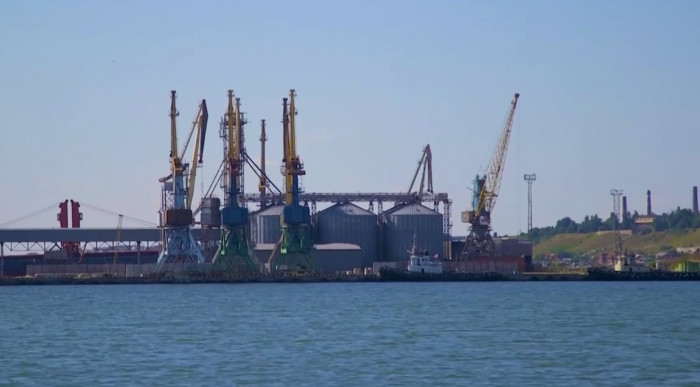
Much of the infrastructure of the port of Berdiansk remains severely damaged. Despite promises, the occupiers have not restored the oil terminal. There is no information on whether the port has been dredged. However, they managed to put the Nova Khortytsia grain terminal into operation in May 2024. “They performed initial repairs on the Nova Khortytsia grain terminal, which is now operational for both receiving and dispatching cargo. Additionally, a grain storage facility with a capacity of 7,000 tons has been added,” said Stelmakhenko.
According to monitoring by the Center for Investigative Journalism, none of the six berths on the eastern side of the Berdiansk port was idle in March 2024. Similar activity was observed in the summer of 2023, when the export of newly harvested grain began. The bulk carriers Kapitan Mironov (IMO 9077563) and Kapitan Yakovlev (IMO 9077575), both of which are ultimately owned by Russian entities, have been repeatedly spotted in the Berdiansk port waters. The occupiers use trucks and trains to transport grain to the port.
It is important to note that the Russians use the port not only to export grain and other goods but also for military purposes. The Russian occupiers export looted goods, including scrap metal, and import ammunition and heavy equipment through the port. This was reported by Viktor Dudukalov, the deputy head of the Berdiansk district council. According to him, the port is equipped with air defense systems and shelters. “It can be argued that the port is now a full-fledged military facility, which the occupiers have equipped for military needs,” Dudukalov added.
The old new railroad
Despite Russian claims of a comprehensive program for the restoration and reconstruction of the ports on the Sea of Azov with appropriate funding from the Russian state budget, its primary objective is to integrate the infrastructure of the ports as much as possible into a new logistics corridor (a railway and highways) through the occupied southern Ukraine to connect the Rostov region of Russia with occupied Crimea, providing an alternative to the Kerch Bridge, primarily to meet the military needs of its army.
Work is being carried out simultaneously in several directions: using the existing Donetsk – Volnovakha – Tokmak railway line, extending it towards Crimea, and creating a new, safer route along the coast of the Sea of Azov from Rostov-on-Don to Taganrog via Mariupol, Berdiansk, and Yakymivka, leading to the city of Dzhankoy.
Unfortunately, the Russians managed to establish a connection from the port of the temporarily occupied Mariupol to the Volnovakha railway station in May this year.
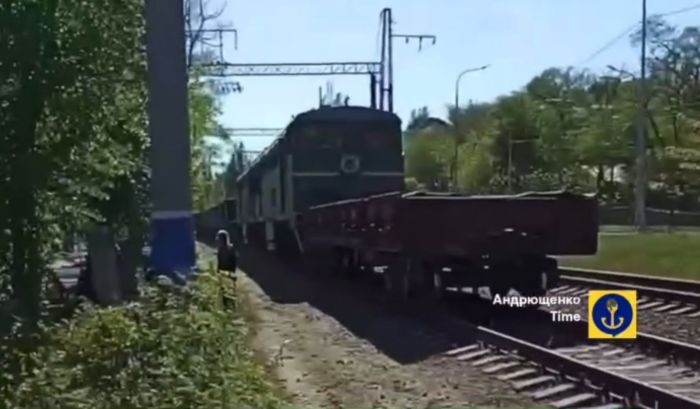
“In addition, they completed a bridge over the Kalmius River near the village of Hranitne in April. This will allow them to connect the occupied territories with Russia and initiate cargo logistics, primarily for military purposes,” said Petro Andriuschenko, an aide to the mayor of Mariupol.
“The railroad from Volnovakha to Mariupol already existed and was in good condition. The Russians had to do most of the work in the city of Mariupol itself, from the railway station to the Mariupol-Sortuvalna station. They hardly involved the local population in the work. They brought in workers from Russia, and it took them about a year to clear the tracks and restore the connection. Now that they have done it, this development unfortunately means a change in the situation for Ukraine. From a commercial logistics standpoint, this railroad will facilitate the transportation of kaolin, coal and ore residues, and scrap metal to the port in much larger quantities. The primary threat, however, is military logistics. The railroad will greatly streamline the occupiers’ logistics to the front lines. Just imagine how much they can hide on the territory of the Illich Iron and Steel Works, for example, if they have a railroad and the huge enclosed area of the iron and steel works,” Andriuschenko said.
The Volnovakha railroad station is one of the largest in the occupied part of the Donetsk region, and this is where the Russians are extending a railway branch from their territory through the settlement of Telmanove (now known as Boikivske).
“After Azovstal was essentially destroyed, the port became the only place in the vicinity of Mariupol where railway rolling stock can now be handled. Both unloading and loading operations can be performed,” said Barskyi. “The port has all the necessary infrastructure for this, such as ramps for unloading heavy wheeled and tracked vehicles, etc. The port could serve as a backup option for the Russian army if, for example, the Kerch Bridge suddenly ceased to exist or as an additional route to reinforce the existing logistics. Before the occupation and the start of the war in 2014, the Volnovakha – Mariupol railway line had a capacity of over 50 pairs of trains per day. In addition, there is electrification, traffic automation, and the presence of large classification yards such as Karan and Kalchik along the route. If the Russians start using these capabilities, it will definitely not bring our victory and the end of the occupation of the region any closer.”
Along the coast of the Sea of Azov
It should be noted that the so-called old railroad is within the range of fire of the Ukrainian army. In some sections, the distance is measured in tens of kilometers. That is why the Russians announced last fall that they would build a new railroad from the Rostov region of Russia to the Crimea along the coast of the Sea of Azov. This is a long-term and complex project, but with their resources, the Russians have begun its construction.
Based on the analysis of satellite images, the Center for Investigative Journalism notes that the Russians have been actively working on this project all last year and continue to do so now, simultaneously in several directions.
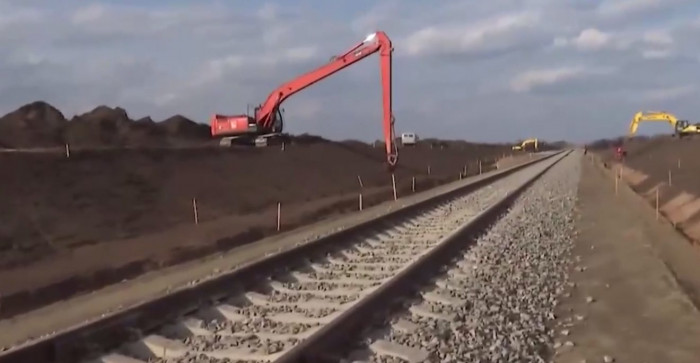
The railroad bridge near Hranitne is one of the most vulnerable points of Mariupol’s railroad connection with the Russian Federation. In January 2024, the Ukrainian Armed Forces attacked the bridge that the occupiers were building to establish a direct railway connection with Mariupol, Volnovakha, and Donetsk. It took the Russians almost three months to repair the bridge. Currently, testing and installation work is nearing completion.
At the same time, in early 2024, the Russians began construction work on the Mariupol – Berdiansk – Yakymivka route. This was stated by Ukrainian intelligence and the “Gauleiter” of the temporarily occupied territories of the Zaporizhia region. The junction station between Mariupol and Berdiansk is supposed to be located near the village of Osypenko, which is equidistant from the two port cities and is located close to the training facility near the village of Novopetrivka, which the Russian military actively uses both for training and for the deployment of personnel.
According to collaborator Balytskyi, in the Zaporizhia region, construction will begin near the village of Yakymivka, south of Melitopol. “There will be a junction there, from which construction will proceed in such a way that we will be able to protect the railroad from shelling. The railroad will then run along the town of Polohy to Orikhiv, through Kamysh-Zoria to Volnovakha. By building a railroad, at least one track, without electric traction, even if it is diesel, we will meet the needs of the military. Most importantly, we will solve the problem of transporting grain to the mainland, as well as the problem of exporting iron ore, scrap metal, coal, and many other elements that we need to connect with the mainland,” he said.
The new rail line will complement the existing R-280 highway, which is currently being widened to four lanes.
The Main Intelligence Directorate believes that the Russians will not be able to complete the construction of the railroad by the end of 2024. “As No of the end of May 2024, preparatory works (creation of earthworks, laying of track ballast, repair/construction of railway bridges, etc.) for the laying of railway tracks are being observed on two sections of the railway route that the enemy plans to build in the TOT (Temporarily Occupied Territories) of Ukraine along the coast of the Sea of Azov. The achievement of the Kremlin’s goal of completing the construction of this railroad by the end of 2024, as reported in several Russian media, is considered highly unlikely,” the Main Intelligence Directorate said.
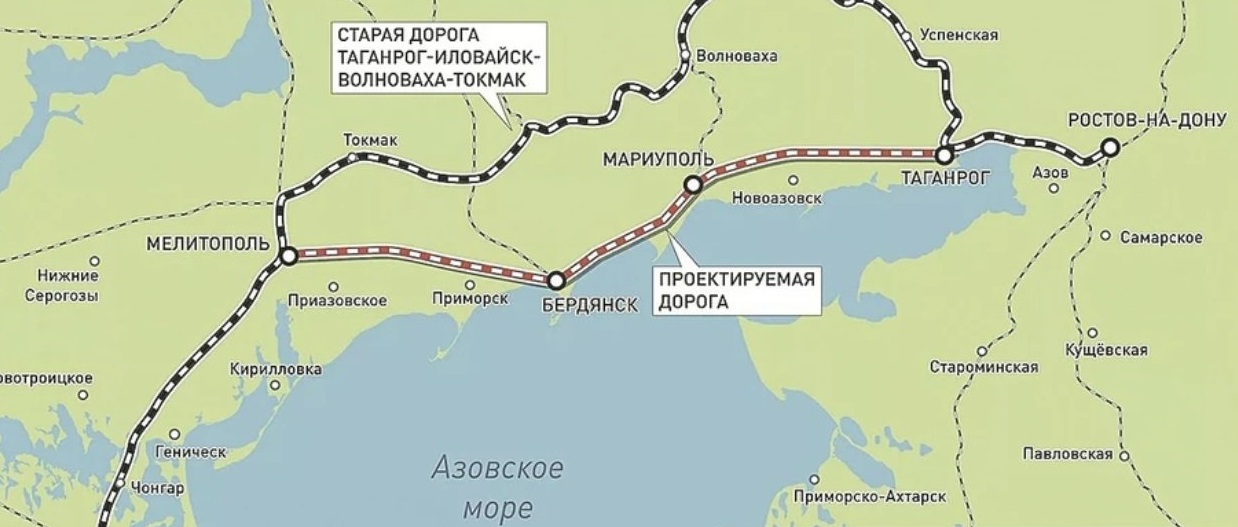
Asked how actively Russia is currently using the Kerch Bridge to supply its army, the Main Intelligence Directorate told the CFTS: “Logistical support for the Russian army in the occupied territories of Ukraine relies primarily on rail transport and to a lesser extent on road and sea transport. The illegally constructed bridge (Kerch Bridge) between the occupied Crimea and the territory of Russia remains a key logistical route for supplying weapons from Russia to occupied Sevastopol and the Zaporizhia and Kherson regions. In the occupied territories of the Donetsk and Luhansk regions, weapons are supplied from the territory of the Russian Federation through the non-government-controlled areas (Voznesenivka – Hukove and Kvashyne – Matveyev Kurgan).”
If the railroad becomes more active in the occupied south of Ukraine, it will shorten the land supply route between Rostov and Crimea for the Russians by 200 kilometers. This will complicate the situation for the Ukrainian Armed Forces. Russia would be able to use the railway as the primary route not only for looting and exporting Ukrainian property, but also for further supplying its army directly to the front line. The enemy is dissatisfied with the situation regarding the Kerch Bridge – it is vulnerable and operates in a limited capacity. Therefore, the occupiers are trying to build another corridor through Pryazovia (the geographical area along the northern coast of the Sea of Azov) as soon as possible, which must be prevented.
